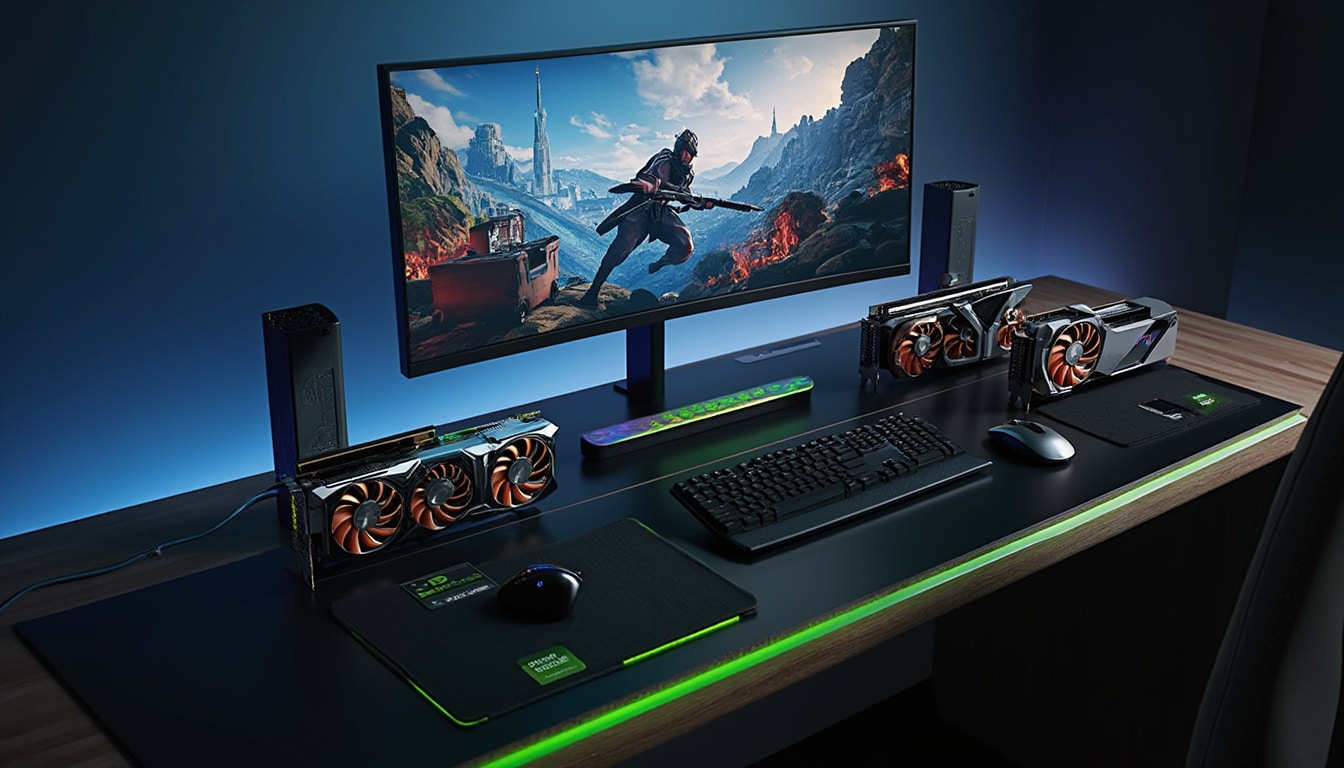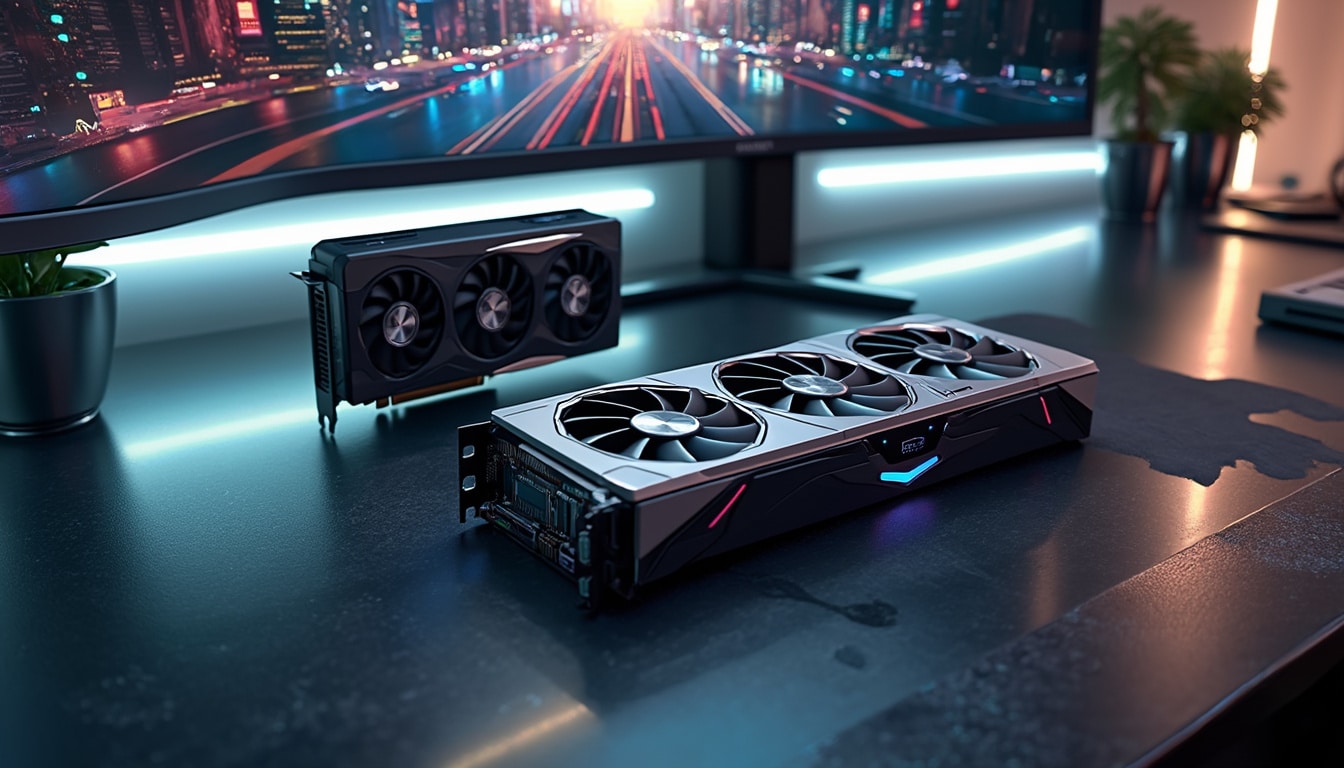Did you know that 70% of gamers feel that realistic graphics significantly elevate their gaming experience? Every ray of light, every reflection, and every shadow behaves just like it does in the real world. That’s precisely what GeForce RTX graphics cards deliver through their advanced technology.
These components go beyond merely displaying images; they digitally replicate the laws of optical physics, providing an unparalleled level of immersion. Games become more profound, visually consistent, and realistic. But how exactly does this technology function? What are its tangible benefits? And perhaps most importantly, how can it revolutionize your gaming experience? Stay on this page, and I’ll cover it all!
If you’ve been keeping an eye on gaming technology news, the name GeForce RTX is likely familiar to you. Developed by the GPU and AI powerhouse NVIDIA, these graphics cards are engineered to provide unmatched graphical power. Their reputation primarily stems from their ability to handle real-time ray tracing, a breakthrough that dramatically changes the appearance of modern video games. The RTX 20 series, launched in 2018, introduced the first dedicated RT cores that enable precise lighting effects calculations, maintaining performance loss to 35% compared to 80% on traditional GPUs.
Since then, subsequent series have continued to enhance this technology alongside other features such as artificial intelligence (AI) and CUDA cores, making the RTX line an excellent choice for enthusiasts of spectacular graphics. Take the RTX 4090, for example, featuring 16,384 CUDA cores and a memory bandwidth of 1,008 GB/s thanks to its 384-bit bus and GDDR6X memory. If these numbers sound like alien language, just remember they’re unprecedented in mainstream gaming.
The most notable technological advancement in GeForce RTX graphics cards is undoubtedly ray tracing, a feature first introduced by the GeForce 256 GPU in 1999. Ray tracing enables incredibly realistic lighting and reflections, once exclusive to NASA and the film industry, now transforming each game scene into a living artwork. Unlike traditional rasterized lighting techniques, ray tracing calculates the exact paths taken by light, delivering unmatched realism. Technical tests show that shadows produced by this approach boast a precision increase of 92% over standard methods.
This demanding technology requires immense computational power, which is why NVIDIA GeForce RTX cards come equipped with specific units dedicated to this task. The third-generation RT Cores in the RTX 40 series reduce calculation latency by 40% compared to the 30 series, making these cards far more performant than their competitors. They remain the ideal choice for those seeking graphical excellence.
Today, many games fully leverage the potential of ray tracing. Titles like Alan Wake 2 and Portal RTX use this technology to provide players with total immersion. The exclusive DLSS 3 technology in the RTX 40 series generates intermediate frames using AI, allowing for up to 200% FPS gains in 4K without compromising visual quality. While some gameplay purists still prioritize raw performance, many are embracing the idea that aesthetics and immersion are essential for a memorable gaming experience.
In short, if you want to max out your graphical settings, choosing a GeForce RTX is almost essential. The RTX series stands out not only for ray tracing but also for its optimized AI management, enriching the user experience down to the finest details.
NVIDIA has truly set a high bar with its revolutionary architectures. The Ampere architecture, featured in the RTX 30 series, marked a significant improvement over its predecessor, offering a better performance-to-consumption ratio with a 30% boost in energy efficiency compared to Turing. For instance, the RTX 3090 Ti delivers 40 TFLOPS of raw power, an unprecedented feat in 2022.
But NVIDIA didn’t stop there. The RTX 40 series, based on the Ada Lovelace architecture, pushes the boundaries even further with boost frequencies reaching up to 2.5 GHz and a 4 nm fabrication process. The RTX 4080 outperforms the 3080 Ti by 50% in rasterized performance. Looking ahead to 2025, the upcoming Blackwell architecture is set to introduce dedicated cores for generative AI, a first in the gaming world.
Another critical aspect of GeForce RTX graphics cards is their internal specifications, particularly VRAM and CUDA cores. VRAM is essential for handling high resolutions and complex textures. The RTX 4070 Ti comes with 12 GB of GDDR6X memory, sufficient for Ultra 1440p gaming, while the RTX 4090 boasts 24 GB, making it indispensable for 8K gaming or professional 3D rendering.
Additionally, the CUDA cores elevate multitasking to new heights. The RTX 4060, with its 3,072 CUDA cores, surpasses the RTX 3060 (which has 3,584 cores) due to architectural optimizations. This demonstrates that raw core counts aren’t the only factor; efficient architecture plays a crucial role. Together, VRAM and CUDA cores create a rich and dynamic visual library for gamers.
Over the years, the evolution of the GeForce RTX series has provided users with continuous technological advancements. The RTX 20 series ushered in the ray tracing era, setting a benchmark for future generations. The RTX 2080 Ti, equipped with 68 RT Cores, struggled to maintain 60 FPS in 1440p with ray tracing enabled—a limitation addressed by the RTX 30 series.
The RTX 30 series brought a significant leap with the RTX 3080 delivering 29 TFLOPS compared to the 2080 Super‘s 13.4 TFLOPS, marking a historic generational jump. Today, the RTX 40 series continues this momentum with technologies like Frame Generation, which reduces system latency by 20% through AI enhancements.
Choosing the right graphics card depends on various factors. An RTX 3060 with 12 GB of memory is ideal for 1080p gaming at 144 Hz, while the RTX 4070 Super excels in 1440p with a controlled TDP of 220 W. For content creators, the RTX 4080 with 16 GB of VRAM easily handles 3D rendering in Blender, halving the computation time compared to the 3080.
Before investing, assess your personal needs. Gamers aiming for 4K will require an RTX 4090, whereas an RTX 4060 Ti is sufficient for eSports. Regardless of your specific situation, each generation of GeForce RTX promises significant advancements in graphical technology.
The integration of artificial intelligence into gaming is becoming increasingly prominent, and the RTX series is at the forefront of this innovation. The DLSS 3.5 introduces Ray Reconstruction, enhancing ray tracing quality by 20% and reducing noise in reflections. This technology sharpens scenes without impacting performance.
With DLSS, RTX cards deliver performance comparable to more powerful machines with fewer resources. In games like Microsoft Flight Simulator, DLSS 3 triples the frame rate in 4K, increasing from 40 to 120 FPS on an RTX 4090. This not only boosts performance in demanding games but also extends the lifespan of your hardware without sacrificing visual quality.
When comparing GeForce RTX cards to their competitors, particularly AMD’s Radeon RX 7000 series, the RTX maintains a significant advantage thanks to its unique ecosystem. The standout feature is DLSS 3.5 with Ray Reconstruction, which surpasses AMD’s FSR in both image quality and performance. For instance, an RTX 4070 Ti Super outperforms a Radeon RX 7900 XT by 15-20% in DLSS-compatible games.
In terms of ray tracing, the difference is even more pronounced. NVIDIA’s dedicated RT cores deliver up to twice the performance of AMD’s hybrid solutions. In Cyberpunk 2077 with path tracing enabled, an RTX 4080 maintains 60 FPS at 1440p, whereas the RX 7900 XTX struggles to reach 30 FPS. The only downside is the price, as RTX cards remain 15-20% more expensive than their AMD counterparts with similar rasterized performance.
The future looks bright for GeForce RTX with the imminent release of the Blackwell architecture. Rumors suggest a 50% improvement in energy efficiency and groundbreaking AI capabilities. NVIDIA is reportedly developing a neural rendering system that can generate textures and objects in real-time using AI, reducing game sizes while enhancing visual quality.
#>

« `html
Table of contents
Togglewhat is the nVIDIA geforce RTX series?
If you’ve ever dived into the gaming world or followed the latest in technology, you’ve likely heard of the GeForce RTX series by NVIDIA. Launched by the GPU and AI powerhouse, NVIDIA, the GeForce RTX cards are engineered to deliver unparalleled graphical performance. But what makes them stand out? These graphics cards are not just heat sinks and silicon; they are marvels of modern engineering designed to push the boundaries of visual fidelity.
From the groundbreaking RTX 20 series introduced in 2018, which brought real-time ray tracing to the masses, to the latest RTX 4090 boasting over 16,000 CUDA cores, the RTX series has continuously evolved. These GPUs are built to handle the most demanding games and applications, ensuring that every pixel is rendered with precision. Whether you’re into fast-paced shooters, sprawling open-world adventures, or intricate simulation games, there’s an RTX card tailored to your needs.
Beyond gaming, the RTX series excels in content creation and professional applications. With features like AI-driven rendering and enhanced ray tracing capabilities, these GPUs are indispensable tools for video editors, 3D modelers, and graphic designers. In short, the GeForce RTX series isn’t just about playing games—it’s about experiencing them in ways previously thought impossible.
how does ray tracing enhance gaming visuals?
Imagine playing your favorite game where every ray of light behaves exactly like it does in the real world. Sounds like sci-fi, right? Welcome to the magic of ray tracing, a technology that has revolutionized gaming visuals. Ray tracing simulates the physical behavior of light, creating lifelike reflections, shadows, and lighting effects that add depth and realism to game environments.
Unlike traditional rendering methods that approximate lighting, ray tracing calculates the actual paths of light rays as they interact with objects. This results in stunningly accurate reflections, refractions, and shadow details. For instance, in a game like Cyberpunk 2077, you can see your character’s reflection in wet streets with pinpoint accuracy, thanks to ray tracing. This level of detail not only makes games look better but also enhances immersion, making you feel like you’re truly part of the virtual world.
NVIDIA’s GeForce RTX cards are at the forefront of bringing ray tracing to mainstream gaming. With dedicated RT Cores, these GPUs handle the intensive calculations required for real-time ray tracing, ensuring smooth performance without compromising on visual quality. As a result, games rendered with RTX ray tracing look more dynamic, vibrant, and realistic than ever before.
what impact do RTX cards have on modern gaming?
The introduction of GeForce RTX graphics cards has had a profound impact on the gaming industry. These GPUs have set new standards for graphical fidelity, pushing game developers to create more visually stunning and immersive experiences. With RTX, games are not just played—they are experienced in a whole new light.
One of the most significant impacts is the widespread adoption of real-time ray tracing. Games like Metro Exodus and Control have showcased how ray tracing can transform game environments, making them more realistic and engaging. This has led to a demand for more powerful hardware, encouraging NVIDIA to continuously innovate and release more advanced RTX models.
Additionally, RTX cards have empowered gamers with features like DLSS (Deep Learning Super Sampling), which uses AI to upscale lower-resolution images in real-time, providing higher frame rates without sacrificing image quality. This blending of AI and graphics technology not only enhances performance but also future-proofs games against the ever-increasing hardware demands.
The RTX series has also influenced the esports scene, where high frame rates and seamless graphics are crucial for competitive play. By delivering both performance and visual quality, RTX cards ensure that gamers have the tools they need to excel, making high-stakes gaming more thrilling and visually impressive.
what are the latest architectures in the RTX series?
NVIDIA’s GeForce RTX series has been home to some of the most advanced GPU architectures in recent years. Starting with the Ampere architecture in the RTX 30 series, NVIDIA brought significant improvements in performance and efficiency. Ampere GPUs feature enhanced CUDA cores, better ray tracing capabilities, and more robust AI processing power, setting a new benchmark for graphics performance.
Moving forward, the Ada Lovelace architecture powers the RTX 40 series, taking everything you loved about Ampere and cranking it up to eleven. With frequencies reaching up to 2.5 GHz in boost mode and a staggering 4 nm process node, Ada Lovelace-based GPUs like the RTX 4080 offer a 50% performance increase over their predecessors in rasterization tasks. This architecture also introduces new features such as Frame Generation, which leverages AI to reduce system latency by 20%, ensuring smoother and more responsive gaming experiences.
Looking ahead, NVIDIA is set to launch the Blackwell architecture in 2025, promising even more groundbreaking features. Rumors suggest that Blackwell will incorporate dedicated cores for generative AI, a first in the gaming industry. This could enable real-time generation of textures and objects, drastically reducing game file sizes and enhancing visual quality without taxing performance.
Each new architecture in the RTX series builds upon the last, integrating the latest technological advancements to keep NVIDIA at the forefront of the GPU market. Whether you’re a casual gamer or a hardcore enthusiast, the latest RTX architectures ensure that your system remains capable of handling the most demanding titles with ease.
what role do VRAM and CUDA cores play in RTX performance?
When it comes to GeForce RTX graphics cards, two critical components determine their performance: VRAM and CUDA cores. Understanding these elements can help you make an informed decision when selecting a GPU that best suits your needs.
VRAM (Video RAM) is the dedicated memory used by your GPU to store and process graphical data. Higher VRAM allows for better performance at higher resolutions and with more complex textures. For instance, the RTX 4070 Ti comes with 12 GB of GDDR6X memory, making it ideal for gaming at 1440p with ultra settings. On the other hand, the flagship RTX 4090 boasts a whopping 24 GB of VRAM, which is essential for 8K gaming and professional 3D rendering tasks.
CUDA cores are parallel processors within the GPU that handle various computing tasks, including rendering graphics and running complex algorithms. More CUDA cores generally mean better performance, as the GPU can handle more tasks simultaneously. For example, the RTX 4060 is equipped with 3,072 CUDA cores, efficiently managing multitasking and delivering smooth gameplay. Interestingly, the RTX 3060 has 3,584 CUDA cores but the RTX 4060 outperforms it due to architectural optimizations, proving that more cores don’t always translate to better performance.
The combination of ample VRAM and a high number of optimized CUDA cores ensures that RTX cards can deliver top-tier performance across a variety of applications. Whether you’re gaming, streaming, or engaging in professional content creation, these components work in harmony to provide a seamless and immersive experience.
For more insights into NVIDIA’s latest offerings, check out their unveiling of the powerful RTX 50 GPUs, where enhanced performance meets innovation, or explore how to choose the right computer for an immersive virtual reality experience this Christmas.
how has the GeForce RTX series evolved over time?
The GeForce RTX series has seen remarkable evolution since its inception, each generation bringing significant enhancements in performance, efficiency, and feature set. Starting with the RTX 20 series in 2018, NVIDIA introduced real-time ray tracing to the mainstream, setting a new standard for visual fidelity in gaming.
The RTX 30 series, based on the Ampere architecture, doubled down on performance improvements. GPUs like the RTX 3080 delivered a remarkable 29 TFLOPS of computing power, a huge leap from the 13.4 TFLOPS of the RTX 2080 Super. This generation also saw enhancements in ray tracing capabilities and the introduction of DLSS 2.0, which significantly boosted frame rates without compromising image quality.
With the launch of the RTX 40 series, NVIDIA continued its tradition of innovation. The Ada Lovelace architecture brought even more power and efficiency, with GPUs like the RTX 4080 outperforming their predecessors by 50% in rasterized performance. The series also introduced DLSS 3 with Frame Generation, reducing system latency and enhancing the overall gaming experience.
Each new generation has not only improved raw performance but also expanded the feature set, making RTX GPUs versatile tools for both gamers and professionals. The upcoming Blackwell architecture promises to introduce generative AI capabilities, further pushing the boundaries of what GPUs can achieve.
This continuous progression ensures that each new RTX generation offers tangible benefits over the last, keeping NVIDIA’s offerings at the cutting edge of GPU technology and maintaining their dominance in the market.
how to choose the right GeForce RTX graphics card for you?
Choosing the right GeForce RTX graphics card can be a daunting task, given the extensive range of options available. To make an informed decision, you’ll need to consider several factors based on your specific needs and use cases.
Resolution and Refresh Rate: If you’re gaming at 1080p with a 144 Hz monitor, an RTX 3060 with 12 GB of VRAM would be sufficient. For 1440p gaming, the RTX 4070 Super offers excellent performance with a controlled TDP of 220 W. Meanwhile, if you’re aiming for 4K gaming or professional 3D rendering, the RTX 4090 with 24 GB of VRAM is your go-to option.
Use Case: Are you a gamer, a content creator, or both? Gamers might prioritize higher frame rates and better ray tracing performance, while content creators will benefit from more VRAM and additional CUDA cores for tasks like video editing and 3D modeling. The RTX 4080, for example, is excellent for both high-end gaming and professional rendering tasks, making it a versatile choice.
Budget: Budget is always a crucial factor. RTX cards range from the more affordable RTX 3060 to the premium RTX 4090. If you’re just starting out or have budget constraints, opting for a mid-range card like the RTX 4070 Ti can offer a balanced mix of performance and price.
Future-Proofing: Investing in a graphics card that can handle future game releases is essential. The latest RTX series, especially the RTX 40 series, offers features like DLSS 3 and enhanced ray tracing that will keep your system relevant for years to come. Additionally, considering the upcoming Blackwell architecture can give you an edge in adopting new technologies as they emerge.
Ultimately, the right GeForce RTX card is one that aligns with your performance needs, budget, and future aspirations. Taking the time to evaluate these factors will ensure that you make a choice that not only meets but exceeds your expectations.
how is AI integrated into RTX gaming experiences?
Artificial Intelligence (AI) has become an integral part of modern gaming, and NVIDIA’s GeForce RTX series is at the forefront of this integration. One of the standout features is DLSS (Deep Learning Super Sampling), which leverages AI to enhance gaming performance and visual quality.
DLSS uses neural networks to upscale lower-resolution images in real-time, allowing games to run at higher frame rates without compromising on image clarity. For example, in Microsoft Flight Simulator, DLSS 3 can triple the frame rate in 4K resolution, going from 40 to 120 FPS on an RTX 4090. This means smoother gameplay and more responsive controls, all while maintaining stunning visual fidelity.
The latest iteration, DLSS 3.5, introduces Ray Reconstruction, which improves the quality of ray-traced reflections by 20% and reduces noise in reflections, resulting in sharper and more realistic scenes. This enhancement ensures that the visual benefits of ray tracing are fully realized without taxing the GPU’s performance.
Furthermore, NVIDIA is exploring generative AI techniques within the RTX ecosystem. The upcoming Blackwell architecture is rumored to include dedicated cores for generative AI, which could allow for real-time generation of textures and objects. This would not only enhance visual quality but also reduce game file sizes, making games more accessible and efficient.
By seamlessly blending AI with graphics processing, NVIDIA’s RTX series is elevating the gaming experience to unprecedented levels. AI-driven enhancements like DLSS ensure that gamers can enjoy high-performance, high-quality visuals even on the most demanding titles.
how do GeForce RTX cards stack up against AMD rivals?
In the competitive world of graphics cards, NVIDIA’s GeForce RTX series and AMD’s Radeon RX lineup are the primary contenders. But how do RTX cards hold up against their AMD rivals? The answer lies in a combination of performance, features, and ecosystem advantages.
Performance and Ray Tracing: NVIDIA RTX cards generally lead in ray tracing performance thanks to their dedicated RT Cores. For example, in games like Cyberpunk 2077, an RTX 4080 maintains 60 FPS at 1440p with ray tracing enabled, whereas the AMD RX 7900 XTX struggles to reach 30 FPS. This significant difference highlights NVIDIA’s edge in delivering smooth, high-quality ray tracing.
AI Features: NVIDIA’s DLSS technology outperforms AMD’s FSR (FidelityFX Super Resolution) in both quality and performance. DLSS 3.5’s Ray Reconstruction offers superior image quality and better performance boosts compared to FSR, making RTX cards more appealing for those who prioritize visual fidelity and high frame rates.
Pricing: One area where AMD often competes is price. RTX cards tend to be 15-20% more expensive than their AMD counterparts at similar rasterization performance levels. While this price premium can be a barrier, many gamers find the additional cost justified by the superior ray tracing and AI features offered by RTX cards.
Ecosystem and Software Support: NVIDIA offers a more robust ecosystem of software and developer support, including features like Game Ready Drivers, Ansel for in-game photography, and GeForce Experience for streamlined game optimization. These tools enhance the overall user experience, giving NVIDIA an edge over AMD in terms of ecosystem integration.
In summary, while AMD provides strong competition, especially in terms of pricing and robust rasterization performance, NVIDIA’s RTX series leads in ray tracing, AI-driven features, and overall ecosystem support. For gamers seeking the best possible graphical experience, RTX cards remain a top choice despite the higher price tag.
what’s next for NVIDIA GeForce RTX?
The future of NVIDIA’s GeForce RTX series looks brighter than ever, with exciting advancements on the horizon. As technology evolves, NVIDIA continues to innovate, pushing the boundaries of what’s possible in graphics processing and AI integration.
One of the most anticipated developments is the upcoming Blackwell architecture, slated for release in 2025. This next-generation GPU architecture is rumored to bring groundbreaking features, including dedicated cores for generative AI. Such capabilities could revolutionize real-time content creation, allowing for the on-the-fly generation of textures and objects, significantly reducing game file sizes and enhancing visual fidelity.
Additionally, NVIDIA is exploring new frontiers in neural rendering, which leverages AI to create more detailed and dynamic in-game environments. This could lead to more immersive and responsive game worlds, where the environment adapts in real-time to player actions and preferences.
The integration of AI is not limited to just graphics enhancements. NVIDIA is also working on improving overall system performance and reducing power consumption. With a rumored 50% gain in energy efficiency with the Blackwell architecture, future RTX cards are expected to deliver better performance while being more power-efficient than ever before.
Moreover, NVIDIA is likely to continue expanding its software ecosystem, incorporating more tools and features that enhance the user experience. From advanced driver support to new AI-driven optimization techniques, NVIDIA ensures that each new RTX generation brings value not just in hardware but also in software innovation.
As the gaming and professional visualization landscapes continue to grow and evolve, NVIDIA’s commitment to advancing the GeForce RTX series ensures that it remains at the cutting edge of GPU technology. With each new release, gamers and professionals alike can look forward to richer, more immersive experiences that redefine the boundaries of what’s possible.













